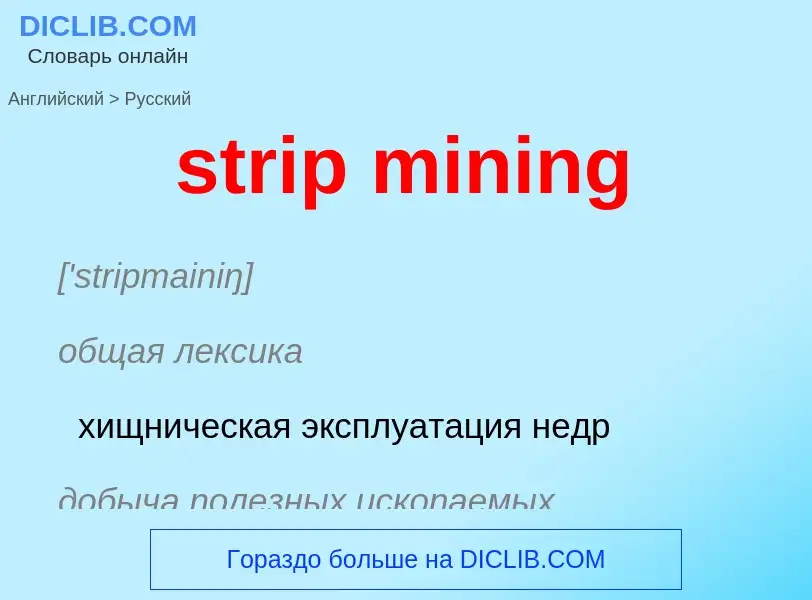Translation and analysis of words by ChatGPT artificial intelligence
On this page you can get a detailed analysis of a word or phrase, produced by the best artificial intelligence technology to date:
- how the word is used
- frequency of use
- it is used more often in oral or written speech
- word translation options
- usage examples (several phrases with translation)
- etymology
strip mining - translation to russian
['stripmainiŋ]
общая лексика
хищническая эксплуатация недр
добыча полезных ископаемых
открытая добыча (ископаемых)
открытая добыча
общая лексика
рудник
Definition
)
Wikipedia

Surface mining, including strip mining, open-pit mining and mountaintop removal mining, is a broad category of mining in which soil and rock overlying the mineral deposit (the overburden) are removed, in contrast to underground mining, in which the overlying rock is left in place, and the mineral is removed through shafts or tunnels.
In North America, where the majority of surface coal mining occurs, this method began to be used in the mid-16th century and is practiced throughout the world in the mining of many different minerals. In North America, surface mining gained popularity throughout the 20th century, and surface mines now produce most of the coal mined in the United States.
In most forms of surface mining, heavy equipment, such as earthmovers, first remove the overburden. Next, large machines, such as dragline excavators or bucket-wheel excavators, extract the mineral.
The pros of surface mining are that it has a lower financial cost and is a lot safer than underground mining because all mining operations take place above the surface. The cons are the hazards it presents to human health and the environment. Humans face a variety of health risks caused by mining such as different cardiovascular diseases, food, and water contamination. Habitat destruction, alongside air, noise, and water pollution, are all significant negative environmental impacts caused by the side effects of surface mining.


![Acid leaching caused by [[sulfide ore]] mining. Acid leaching caused by [[sulfide ore]] mining.](https://commons.wikimedia.org/wiki/Special:FilePath/Acid Mine Drainage.jpg?width=200)
![The [[Bagger 288]] is a [[bucket-wheel excavator]] used in strip mining. The [[Bagger 288]] is a [[bucket-wheel excavator]] used in strip mining.](https://commons.wikimedia.org/wiki/Special:FilePath/Bagger-garzweiler.jpg?width=200)
![The [[El Chino mine]] located near [[Silver City, New Mexico]] is an open-pit copper mine. The [[El Chino mine]] located near [[Silver City, New Mexico]] is an open-pit copper mine.](https://commons.wikimedia.org/wiki/Special:FilePath/Chino copper mine.jpg?width=200)
![Coal strip mine in [[Wyoming]] Coal strip mine in [[Wyoming]]](https://commons.wikimedia.org/wiki/Special:FilePath/Coal mine Wyoming.jpg?width=200)
![Centre County]], [[Pennsylvania]]. Centre County]], [[Pennsylvania]].](https://commons.wikimedia.org/wiki/Special:FilePath/Flickr - Nicholas T - German Settlement Reclamation Project (Revisited) (2).jpg?width=200)


![[[Dawson City]], Yukon, Canada, in 1957. [[Dawson City]], Yukon, Canada, in 1957.](https://commons.wikimedia.org/wiki/Special:FilePath/Dawson City, Yukon in 1957.jpg?width=200)
